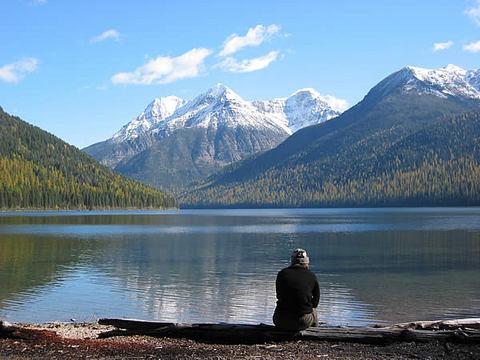In a sign of how difficult it can be to overturn mistakes in national parks, crews in Yellowstone National Park are moving into their second decade of fighting non-native lake trout in Yellowstone Lake, where they're threatening to wipe out the lake's native cutthroat trout population.
The "lakers" are thought to have gained access to the big lake back in the 1980s when a park visitor presumably figured the species would be a great game fish. Unfortunately, the much larger lake trout viewed the much smaller cuts as prey and, well, things started to go downhill.
Now Glacier National Park officials are taking their own battle against lake trout to Quartz Lake, which shimmers in the park's northwestern corner. True, Quartz Lake is nowhere as large as Yellowstone Lake, and so the battle might not be as difficult. But crews also don't have the luxury of a road leading right up to the lake.
Now, until recently Quartz Lake was viewed as the largest natural lake in the entire Columbia River Basin with native fish populations not compromised by non-native fish species. Five years ago Glacier officials took a step they hoped would preserve that distinction -- they constructed a fish passage barrier to prevent lake trout from invading Quartz Lake. Unfortunately, lake trout were subsequently discovered in Quartz Lake in 2005.
Lake trout first found their way into the park's waters after being introduced into nearby Flathead Lake about a century ago. Though it took some time, they were able to slowly expand their distribution and abundance throughout the Flathead Basin. Lake trout subsequently reached Glacier and in the relatively short pan of about 30 years replaced bull trout as the dominant aquatic predator in most of the park’s large west-side lakes.
Now Glacier resource managers are proposing a project to determine the status of lake trout in Quartz Lake and implement a project to remove them. While the proposed project would take place on Quartz Lake, it has the potential to protect the native fishery of the entire upper Quartz Lake system which includes Middle Quartz, Quartz, and Cerulean lakes.
The upper Quartz Lake system is located within recommended wilderness in the North Fork of the Flathead River watershed. Native fish species in this complex include bull trout, classified under the Endangered Species Act as “threatened,” westslope cutthroat trout, a Montana state species of special concern, and mountain whitefish.
To date, park staff have identified alternatives that would either 1) maintain current management of the Quartz Lake drainage; 2) conduct a four-year radio telemetry and experimental netting project that would require the use of an 18-foot (or larger), motorized boat to remove lake trout; or 3) use a non-motorized watercraft to conduct hook-and-line and, weather permitting, small netting operations for lake trout evaluation and lethal removal.
The following impact topics have been identified: Fisheries/Aquatic Species, Wilderness, Visitor Use and Experience, Wildlife, Threatened, Endangered and Species of Concern, Water Quality, Natural Sound, and Visitor Use and Experience.
Between now and April 6 park officials are taking comments on what the environmental assessment to be conducted on lake trout removal should consider. Scoping is an early and open process that occurs prior to the development of an EA. Scoping comments are used to identify resource issues and alternatives that should be addressed in the analysis.
After the EA is completed, the public will have an opportunity to review and comment on the document.
Scoping comments can be provided electronically through the park’s planning, which you can find by surfing over to this website and selecting the lake trout removal project. Written comments can also be submitted to: Superintendent, Glacier National Park, Attn: Quartz Lake EA, P.O. Box 128, West Glacier, Montana 59936.
As for Yellowstone's lake trout problem? Late last summer a panel comprised by 15 fisheries scientists reviewed the progress the park was making in battling the lake trout and concluded that Yellowstone Lakes cutthroat trout population remains in danger of being over-run.




Comments
Hi: The best way to hold down lake trout populations is to introduce Cisco, which has a double predator-prey relationship with LT. To obtain more
information on this you can read a recent paper by fish biologist Leon Carl. His paper is entitled "Lake Trout demographics to burbot and
coregonine populations in the Algonquin Highlands of Ontario". Since after many years of Gill Netting the cutthroat trout in Yellowstone Lake
are still in danger of being over-run, it is time for a different approach to solving the LT problems in National Park lakes.
Hi: In looking over my comment to you on 10/2209, I see that predator and gill are not spelled correctly. Sorry about that! AGP
There are problems with introductions of any non-native fish species. The biggest question being, how are they going to affect the native fauna of the system? Until you know for sure that the introduction is not going to have a negative affect, then you have to assume that the introduction would not be the right choice. We have made numerous mistakes with introducing biota in the past and many of them we are now trying to reverse the negative affects of. Thats how lake trout got to the western states to begin with. Unfortunately, bio controls are not the best option for reducing lake trout from any system. Gill netting alone with never totally remove lake trout from a large body of water, but if keeping the lake trout population suppressed gives the native cutthroat a fighting chance till better techniques are developed, thats what should continue.